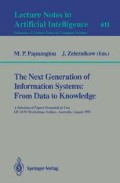Abstract
Many real-world problems are solved through the cooperative efforts of multiple problem-solving agents. These agents are often characterized by specific skills or domains of expertise, and are often best situated at distinct, geographically distributed locations. In cases where these skills are related to remotely accessing information, transparency is desirable, such that information consumers need not know either the location of the information or its internal structure. This paper describes a strategy that combines four techniques to solve such problems: (1) an architecture for coarse-grained agents (CGAs), (2) a communication protocol that enables CGAs to interact, (3) an intermediate query language (IQL), designed around user-level concepts, and (4) a query translation mechanism that transforms IQL requests into database-specific queries. A prototype implementation, known as oMIE, is briefly described.
Preview
Unable to display preview. Download preview PDF.
References
Agha, G.A. 1986. ACTORS: A Model of Concurrent Computation in Distributed Systems. The MIT Press. Cambridge, Massachusetts.
Agha, G.A. 1986. “An Overview of Actor Languages”. SIGPLAN Notices, 21(10), p. 58–67.
Blumenthal, R.L., S.C. Laufmann, and E.H. Freeman. 1990. “OOOFFs: A metamorphosis from objects to knowledge-based agents”, in Bellcore Object Oriented Systems and Technology (BOOST) Conference. New Jersey. Bellcore.
Bobrow, D. 1990. “Dimensions of Interaction: Looking Towards an Interaction Level”. AAAI Presidential Address, AAAI-90.
Bond, A.H. and L. Gasser. 1988. “An Analysis of Problems and Research in DAI”, in Readings in Distributed Artificial Intelligence, A.H. Bond and L. Gasser, eds. p. 3–35. Morgan Kaufmann Publishers. Los Altos, California.
Clinger, W.D. 1981. “Foundations of Actor Semantics”. Technical Report, #AI-TR-633. Massachusetts Institute of Technology.
Davis, R. and R.G. Smith. 1983. “Negotiation as a Metaphor for Distributed Problem Solving”. Artificial Intelligence, 20(1), p. 63–109.
Durfee, E.H., V. Lesser, and D.D. Corkill. 1987. “Cooperation Through Communication in a Distributed Problem Solving Network”, in Distributed Artificial Intelligence, M.N. Huhns, ed. p. 29–58. Morgan Kaufmann Publishers. Los Altos, CA.
Durfee, E.H., V.R. Lesser, and D.D. Corkill. 1987. “Coherent Cooperation Among Communicating Problem Solvers”. IEEE Transactions on Computers, C-36, p. 1275–1291.
Freeman, E.H. 1990. “A2: An Agent-Oriented Programming Architecture for Multi-Agent Constraint Satisfaction Problems”, in The IEEE Conference on Tools for Artificial Intelligence. Herndon, VA. IEEE Computer Society Press.
Gasser, L., C. Braganza, and N. Herman. 1987. “Implementing Distributed AI Systems Using MACE”, in The Third IEEE Conference on Artificial Intelligence Applications. Kissimmee, FL. IEEE Computer Society Press.
Gasser, L., C. Braganza, and N. Herman. 1987. “MACE: A Flexible Testbed for Distributed AI Research”, in Distributed Artificial Intelligence, M.N. Huhns, ed. p. 119–152. Morgan Kaufmann Publishers. Los Altos, CA.
Gasser, L. and M.N. Huhns, eds. 1989. Distributed Artificial Intelligence, Volume II. Morgan Kaufmann Publishers. Los Altos, CA.
Hewitt, C. 1977. “Viewing Control Structures as Patterns of Passing Messages”. Artificial Intelligence, 8(3), p. 323–364.
Hewitt, C. 1985. “The Challenge of Open Systems”. BYTE, April, 1985, p. 223–242.
Hewitt, C. and H. Baker. 1977. “Laws for Communicating Parallel Processes”, in 1977 IFIP Congress. Elsevier Science Publishers.
Hewitt, C.E. 1986. “Offices are Open Systems”. ACM Transactions on Office Information Systems, 4(3), p. 271–287.
Huhns, M.N., ed. 1987. Distributed Artificial Intelligence. Morgan Kaufmann Publishers. Los Altos, CA.
Lenat, D.B. and R.V. Guha. 1990. Building Large Knowledge-Based Systems: Representation and Inference in the Cyc Project. Addison-Wesley Publishing Company. Reading, MA.
Lesser, V.R. and D.D. Corkill. 1983. “The Distributed Vehicle Monitoring Testbed: A Tool For Investigating Distributed Problem Solving Networks”. The AI Magazine, 4(3), p. 15–33.
Marschak, J. and R. Radner. 1972. Economic Theory of Teams. Yale University Press. New Haven, CT.
Micallef, J. 1988. “Encapsulation, Reusability and Extensibility in Object-Oriented Programming Languages”. Journal of Object-Oriented Programming, 1(1), p. 12–36.
Nii, H.P. 1986. “Blackboard Systems: Blackboard Application Systems, Blackboard Systems from a Knowledge Engineering Perspective”. The AI Magazine, 7(3), p. 82–106.
Nii, H.P. 1986. “Blackboard Systems: The Blackboard Model of Problem Solving and the Evolution of Blackboard Architectures”. The AI Magazine, 7(2), p. 38–53.
Pratt, D. 1991. “Working Set Triage”, personal communication.
Shoham, Y. 1990. “Agent-Oriented Programming”. Technical Report, #STAN-CS-90-1335. Stanford University.
Smith, R.G. 1980. “The Contract Net Protocol: High-Level Communication and Control in a Distributed Problem Solver”, in Readings in Distributed Artificial Intelligence, A.H. Bond and L. Gasser, eds. p. 357–366. Morgan Kaufmann Publishers. Los Altos, CA.
Smith, R.G. 1981. A Framework for Distributed Problem Solving. UMI Research Press. Ann Arbor, MI.
Smith, R.G. and R. Davis. 1980. “Frameworks for Cooperation in Distributed Problem Solving”, in Readings in Distributed Artificial Intelligence, A.H. Bond and L. Gasser, eds. p. 61–70. Morgan Kaufmann Publishers. Los Altos, CA.
Stefik, M. and D.G. Bobrow. 1986. “Object-Oriented Programming: Themes and Variations”. The AI Magazine, 6(4), p. 40–62.
Zimmerman, H. 1980. “OSI Reference Model — The ISO Model of Architecture for Open Systems Interconnection”. IEEE Transactions on Communications, 28, p. 425–432.
Author information
Authors and Affiliations
Editor information
Rights and permissions
Copyright information
© 1992 Springer-Verlag Berlin Heidelberg
About this paper
Cite this paper
Laufmann, S.C. (1992). Coarse-grained distributed agents for transparent access to remote information. In: Papazoglou, M.P., Zeleznikow, J. (eds) The Next Generation of Information Systems: From Data to Knowledge. IJCAI 1991. Lecture Notes in Computer Science, vol 611. Springer, Berlin, Heidelberg. https://doi.org/10.1007/3-540-55616-8_50
Download citation
DOI: https://doi.org/10.1007/3-540-55616-8_50
Published:
Publisher Name: Springer, Berlin, Heidelberg
Print ISBN: 978-3-540-55616-9
Online ISBN: 978-3-540-47262-9
eBook Packages: Springer Book Archive

